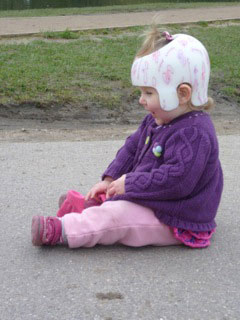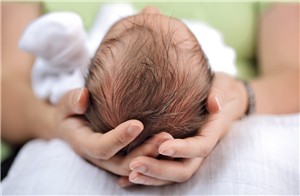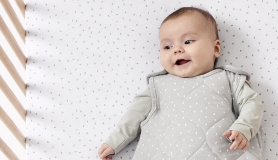When Alicia was born her head was a little swollen and wonky but like most parents I assumed it would settle in time. At around five months old, I noticed her head shape had not improved. Health visitors advised me that some flattening can typically occur due to the relatively large proportion of time a young baby spends lying down and it would likely adjust as she grows and in time and settle into a more symmetrical shape. In fact Alicia rarely spent time lay down; she has always been happiest in a sling, never slept in a cot and didn’t go in a pram until she was around 6 months old. Nevertheless for a while we accepted the advice and continued to wait and see as advised.
At five and half months Alicia started to become more mobile, she could sit up and was rolling from front to back, but her head shape still looked distorted – there was a noticeable flat spot on one side of her head and now a bulge on her forehead. As parents, we began to question whether the ‘proportion of time lying down’ was a significant contributor to the condition and began to do our own research on the internet. Alongside this we requested our GP make a referral to a paediatrician.
Alicia was diagnosed by an NHS Paediatrician as having Positional Plagiocephaly aged 11 months but we were advised not to be concerned as in due course her long hair would disguise the flatness and unfortunately there was no NHS treatment available for such a condition.
For a while we were reassured by this ‘specialist’ assessment but then we came across Headstart4Babies, a UK charity run by Philip Saich and Karen Laker, whose baby Ben was treated for severe plagiocephaly in 2004/2005.
Headstart4Babies aims to raise awareness of plagiocephaly and brachycephaly, conditions which are being diagnosed in an increasing number of babies. Research that we found suggested that the condition if untreated can lead to distortion of the child’s face, the ears being wrongly aligned; and possible problems with the jaw and neck.
From the website we found that Plagiocephaly and brachycephaly can be treated using a non-invasive helmet and treatment is most effective between the ages of four and 12 months, as that is when the skull is experiencing its most rapid growth and is at its most malleable. The helmet fits snugly to the unaffected area and leaves space around the flat spot so that any growth is channeled into the area which needs to even out. Helmets do not restrict head growth or affect brain development, and regular check-ups enable new measurements to be taken and any consequent adjustments to be made.
Still with mixed feelings but now with a sense of urgency we approached two clinics for a free assessment and consultation. We were aware that any subsequent treatment would be costly but agreed to cross that bridge when we got to it.

Alicia’s head shape was measured using a digital camera scanner; the asymmetry was highlighted as falling into the severe range. Once we agreed to proceed the process was moved along as quickly as possible, the measurements were used to make a model of Alicia’s head shape in order to make her hat.
We found stories and play helpful in preparing Alicia and her elder sister, Amelie for the new hat, the girls put hats on their dolls and teddies and Amelie role played trips to the Doctors. We explained to her that Alicia would be wearing a magic hat to help her head become a nice round shape. Amelie had started school that September and we knew that it was possible that she could be unsettled by the additional change and she needed a story to tell to her friends when they asked about her sister’s hat. We spent time in school with Amelie and her teachers talking openly about Plagiocephaly and within the classroom, individual similarities and differences were explored with Amelie’s class mates.
Alicia was fitted with her hat on 1 October 2011, shortly before her first birthday, we arrived for Alicia first hat fitting and, in the waiting room, met a family with a little boy aged 15 months. He had been wearing his hat around 6 months and because the change had been so dramatic they had chosen to leave it a little longer than planned. He dashed around the waiting room, in and out of the toy boxes, back and forth to his family, without a care in the world.
We had been prepared that the initial fitting is often an emotional time for parents but we knew our reaction would have a bearing on how Alicia responded and that we were keen to make it a positive experience for her. After talking to his mum in the waiting room, and seeing him so happy and unaffected by his hat we felt instantly better and all the more prepared to see Alicia wearing her new hat. The appointment went smoothly and she took to her hat in an instant and I know we are biased but she looked so cute!
That weekend we were due to take the girls to Blackpool illuminations, we had wondered whether such a big outing maybe a bit overwhelming for us as a family given that we were all getting used to the hat but Amelie was so excited to show her sister the illuminations and more than that we felt we all needed a treat because of the worry and stress of the last few weeks so off we went.
The car journey was intense, Amelie’s excitement had peaked, crashed and burned and if I am being honest we were still feeling a little tense but once we were there it was all forgotten. The girls both squealed with delight as we strolled along the promenade at the north side away from the crowds and where the illuminations were more geared up for little people.
Being away from home and being anonymous put all our worries into perspective. Seeing the girls holding hands giggling with glee we felt lucky that Alicia’s development seemed unaffected by her condition and that we were able to give her the best possible start in life.
Since this point we have not looked back and after a short settling in period Alicia wore her magic hat for the prescribed 23 hours a day, seven days a week.
We had a number of concerns prior to the hat being fitted; the main one being would she adjust to her new hat; we worried that it maybe uncomfortable for her and we were so relieved that she was simply not affected by her hat– in fact she missed it when it came off for an hour and, however much of cliché it may sound, it has become a part of the family’s everyday life. Amelie was unperturbed also and in fact told us “I want a hat like Alicia!”
Being a Play Therapist, I know only too well that children explore their own experiences through play and in fact play can be self healing:
‘Play permits the child to resolve in symbolic form unsolved problems of the past and to cope directly or symbolically with present concerns. It is also his most significant tool for preparing himself for the future and its tasks.’ Bruno Bettelheim.1976.
For a short while Amelie chose to wear her bicycle helmet around the house and Alicia spent time brushing her dolls hair I guess because she could not brush her own so easily.
Another concern we had was whether we could continue bed sharing but this has not been a problem either, we simply needed to be careful that Alicia did not overheat, her hat made it more difficult for her to regulate her temperature and in bed she should only have light bedding.
There has been one additional benefit to the hat when Alicia was learning to walk it offered great protection being the youngest of two children life was full of rough n’ tumble play!
Alicia’s hat has attracted a lot of interest, initially it felt hard when some people would point and stare in the street but now we don’t notice. Mostly people comment on how beautiful she looks or ask me to talk through their concerns about their own child’s head.
I remember the first time she wore her hat to a baby music class we went along to occasionally, a couple of children moved in close to her to get a good look at her hat and when they could barely contain their curiosity I told them about the hat’s magic powers!
Alicia’s hat is looking well worn now; her zest for exploring her world with a hands on approach has meant that her hat has been well road tested with food, mud and paint!
Now Alicia aged almost 18 months is now due to have her hat removed, the change has been dramatic and now the flatness is barely noticeable. The next task is to adjust to seeing our little girl hat free which will be strange, she started the treatment as our baby and is now our little girl, her hair has grown under the hat and she looks completely different.
Advice to worried parents:
• Discuss your concerns as soon as possible with health professionals and request advice about repositioning, repositioning works on the theory that by moving the baby’s head from one side to the other you will reduce the external pressure to one area and encourage the head to round out on its own.
• Check out the Head Start 4 Babies website: www.headstart4babies.co.uk.
• Seek a free consultation from a clinic offering helmet therapy; there are links to established clinics on the Head Start 4 Babies website.
• Also see British Association of Play Therapists – www.bapt.info.







